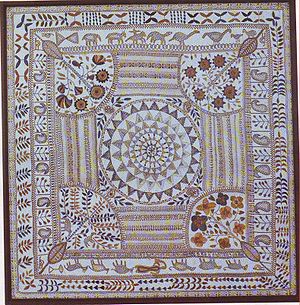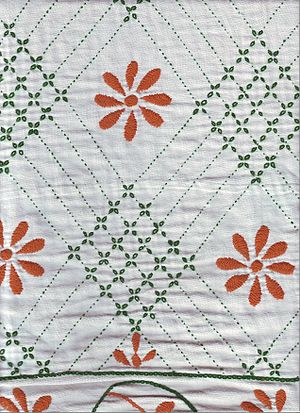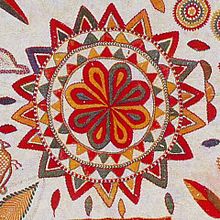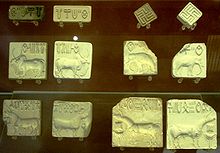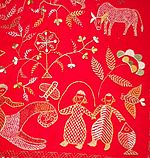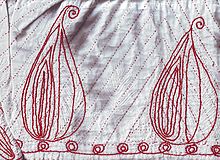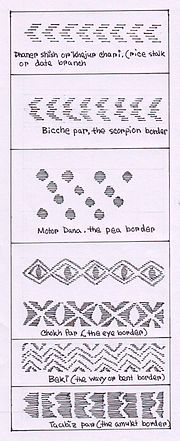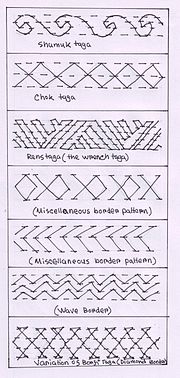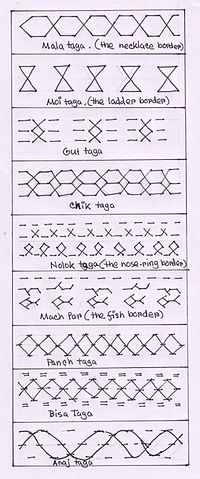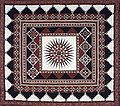- Nakshi Kantha
-
Nakshi Kantha, a type of embroidered quilt, is a type of folk art of Bangladesh and West Bengal, India.[1] The art has been practiced in rural Bengal for centuries.[2] The name "nakshi kantha" became popular among literate people after the publication of Jasimuddin's poem Naksi Kanthar Math (1929).[3] The basic material used is thread and old cloth.[4] Kanthas are made throughout Bangladesh, but the greater Mymensingh, Rajshahi, Faridpur and Jessore areas are most famous for this craft.[5]
The colourful patterns and designs that are embroidered resulted in the name “Nakshi Kantha”, which was derived from the Bengali word “naksha”, which refers to artistic patterns.[6] The early kanthas had a white background accented with red, blue and black embroidery; later yellow, green, pink and other colours were also included. The running stitch called "kantha stitch" is the main stitch used for the purpose.[7] Traditionally, kantha was produced for the use of the family. Today, after the revival of the nakshi kantha, they are produced commercially.
Etymology
The word kantha has no discernable etymological root.[8] The exact time of origin of the word kantha is not accurately known but it probably had a precursor in kheta (khet in Hindi and Bangla means "field").[9] According to Niaz Zaman, the word kantha originated from the Sanskrit word kontha, which means rags, as kantha is made of rags.[10]
The Kantha Tradition
Like any other folk art, kantha making is influenenced by factors such as materials available, daily needs, climate, geography, and economic factors.[11] Probably the earliest form of kantha was the patch work kantha, and the kanthas of the decorative applique type evolved from this.[12]
Kantha in Literature
The earliest mention of Bengal Kantha is found in the book "Sri Sri Chaitanya Charitamrita" by Krishnadas Kaviraj, which was written some five hundred years ago.[13]
Kantha Making
Traditionally old sarees, lungis and dhotis were used to make kanthas. Kantha making was not a full time job. Women in almost every household were expert in the art. Rural women worked at leisure time or during the lazy days of the rainy season, so taking months or even years to finish a kantha was normal. At least 5-7 sarees were needed to make a standard size kantha. Today the old materials are replaced by new cotton cloths. Traditionally the thread was collected from the old sarees. That is rarely done today.
When making a kantha, first the sarees are joined together to attain the required size, and then layers are spread out on the ground. The cloths are then smoothed, leaving no folds or creases in between. During the process, the cloth is kept flat on the ground with weights on the edges. Then the four edges are stitched and two or three rows of large running stitches are done to keep the kantha together. At this stage, the kantha can be folded and stitched at leisure time.
Originally, designs and motifs were not drawn on the cloth. The design was first outlined with needle and thread, followed by focal points, and then the filling motifs were done. In a kantha with a predominant central motif the centre was done first, followed by corner designs and the other details. In some types of kanthas (carpet, lik and sujni, etc.) wooden blocks were used to print the outline. The blocks are replaced today by patterns drawn in tracing papers.
Different Types of Kantha
The following is how kanthas are categorized, according to the stitch type: [14]
Running Stitch
The Running stitch kantha is truly the indigenous kantha. They are subdevided into Nakshi (figured) and par tola (patterned). Nakshi (figured) kanthas are further divided into motif or scenic kanthas.
Lohori Kantha
The name was derived from Persian word ‘lehr’, which means wave. This type of kantha is particularly popular in Rajshahi. These kanthas are further divided into soja (straight or simple), Kautar khupi (pegion coop or triangle), borfi or diamond (charchala, atchala or barachala).
Lik/Anarasi
The Lik or Anarasi (pine apple) type of kantha is found in the Chapainawabgonj and Jessore areas. The variations are lik tan, lik tile, lik jhumka, and lik lohori.
Cross Stitch/Carpet
This type of kantha was introduced by the English during the British Rule in India.[15] The stitch employed in these kanthas is the cross stitch.
Sujni Kantha
This type of kantha is found only in Rajshahi area.The popular motif used is the undulating floral and vine motif.
Influence of Religion and Folk Belief
Kantha Stitches
The earliest and most basic stitch found in kanthas is the running stitch. The predominant form of this stitch is called the phor or kantha stitch.[16] The other forms of stitches used are the Chatai or pattern darning, Kaitya or bending stitch, weave running stitch darning stitch, Jessore stitch(a variation of darning stitch), threaded running stitch, Lik phor or anarasi or ghar hasia (Holbein) stitches. The stitches used in modern day kantha are the Kasmiri stitch and the arrow head stitch. Stitches like the herring bone stitch, satin stitch, back stitch and cross stitch are occasionally used.[17]
Types
Kanthas generally denote quilts used as wrappers; however, all articles made by quilting old cloth may also be referred to by the same generic name. However, depending on the size and purpose, kanthas may be divided into various articles, each with its specific names. The various types of kantha are as follows:[18]
- Quilt (lep in Bangla)
- A light quilted covering made from the old sarees/dhotis/lungis and sometimes from sheet cloths.
- Large spread (Naksi Kantha in Bangla)
- An embellished quilt embroidered in traditional motifs and innovative style
- Puja floor spread (Ason in Bangla)
- Cloth spread for sitting at a place of worship or for a honoured guest.
- Cosmetic wrapper (Arshilota in Bangla)
- A narrow embroidered wrapper to roll and store away a woman's comb, mirror, eye kohl,vermilion, sandal paste, oil bottle, etc.Often, a tying string is used to bind the wrap, as in later day satches.
- Wallet (Batwa thoiley in Bangla)
- Small envelop shaped bag for keeping money, betel leaves, etc.
- Cover for Quran (ghilaf in Arabic and Bangla)
- Envelope shaped bag to cover the Quran.
- Prayer mats (Jainamaz in Bangla)
- Mats used by Muslims to say prayers.
- Floor spread (Galicha in Bangla)
- Floor coverings.
- Cloths wrapper (Bostani, guthri in Bangla)
- A square wrapper for books and other valuables.
- Cover (Dhakni in Bangla)
- Covering cloths of various shapes and sizes.
- Ceremonial meal spread (Daster khan in Bangla)
- A spread for eating place, used at meal time.
- Pillow cover (Balisher chapa or oshar in Bangla)
- A flat single piece pillow cover.
- Handkerchief (Rumal)
- Small and square in shape.
- Modern day articles
- Today newer uses are found for nakshi kanthas, such as bedspreads, wall hangins, cushion covers, ladies' purses, place mats, jewellery boxes, dress fronts, skirts border, shawls and sharees.
Motifs
Motifs of the nakshi kantha are deeply influenced by religious belief and culture. Even though no specific strict symmetry is followed, a finely embroidered naksi kantha will always have a focal point. Most kanthas will have a lotus as focal point, and around the lotus there are often undulating vines or floral motifs, or a shari border motif. The motifs may include images of flower and leaves, birds and fish, animals, kithen forms even toilet articles.
While most kantas have some initial pattern, no two naksi kantas are same. While traditional motifs are repeated, the individual touch is used in the variety of stitches, colours and shapes. The notable motifs found in naksi kantha are as follows:
The Lotus Motif
The lotus motif is the most common motif found in kanthas. This motif is associated with Hindu iconography and thus is also very popular in the kantha. The lotus is the divine seat. It is also symbolic of cosmic harmony and essential womanhood. The lotus is also the symbol of eternal order and of the union of earth, water and, sky. It represents the life-giving power of water, and is also associated with the sun for the opening and closing of the petals. It is also the symbol of the recreating power of life. With the drying up of water, the lotus dies and with the rain it springs to life again. The lotus is associated with purity and the goddess Laksmi, the goddess of good fortune and abundance. There are various forms of lotus motifs, from the eight-petaled astadal padma to the hundred petaled satadal. In the older kanthas, the central motif is almost always a fully bloomed lotus seen from above.
The Solar Motif
The solar motif is closely associated with the lotus motif. Often, the lotus and the solar motifs are found together at in the centre of a nakshi kantha. The solar motif symbolizes the life giving power of the sun. The sun is associated with the fire which plays a significant part in Hindu rites, both religious and matrimonial.
The Moon Motif
The moon motif has a religious influence, and is popular amongst the Muslims. Mostly it is in the form of a crescent moon accompanied by a star. This motif is particularly found in jainamaz kanthas.
The Wheel Motif
The wheel is a common symbol in Indian art, both Hindu and Buddhist. It is the symbol of order. The wheel also represents the world. The wheel is a popular motif in kanthas even when the maker has forgotten the significance of the symbol. The motif is relatively easy to make with chatai phor.
The Swastika Motif
Su asti in Sanskrit means it is well. As a motif in Indian art, it dates back to the Indus Valley civilization. It is symbol of good fortune. It is also known as muchri or golok dhanda. With the passage of time, the design is more curvilinear than the four armed swastika of the Mohenjodaro seal. The symbolic design has significant influence in Hinduism, Buddhism, and Jainism.
The Tree of Life Motif
The influence of this motif in Indian Art and Culture (as with kantha) may be traced back to the Indus Valley civilization. It is likely that the Indus people conceived the pipal as the Tree of Life...with the devata inside embodying the power of fecundity.[19] During the Buddhist times, the cult of the tree continued. Pipal is sacred to the Buddha because he received enlightenment under its shade. It reflects the fecundity of nature and is very popular in Bengal. Vines and creepers play an important role in kanthas and they contain the same symbolisation as that of tree of life. A popular motif in Rajshahi lohori is thr betel leaf.
The Kalka Motif
This is a latter day motif, dating from Mughal times.[20] The kalka or paisley motif originated in Persia and Kashmir and has become an integral image of the subcontinental decorative motif.[21] It can be compared with a stylized leaf,mango or flame. The kalka is an attractive motif and number of varieties are experimented. Similar motifs can be found in traditional kashmiri Shawls.
Other motifs=
- The Water Motif:
- The Mountain Motif:
- The Fish Motif:
- The Boat Motif:
- The Footprint Motif:
- The Rath[disambiguation needed
 ] Motif:
] Motif: - The Mosque Motif:
- The Panja or Open Palm Motif:
- Agricultural Implements:
- Animal Motifs:
- Toilet Articles:
- Kithen Implements:
- The Kantha Motif:
- The Palanquin Motif:
Borders
Most nakshi kanthas have some kind of border. Either a sari border is stitched on or a border pattern is embroidered around the kantha. The common border found in kanthas are as follows:[22]
- The Paddy stalk or date branch (dhaner shish or khejur chari)
- The Scorpion border(Biche par in bangla)
- The Wavy or bent Border (Beki in bangla)
- The Diamond border (Barfi)
- The Eye border (chok par in bangla)
- The Amulet border (Taabiz par in bangla)
- The Necklace border (mala par in bangla)
- The Ladder Border (Moi taga)
- The Gut taga
- The Chick taga
- The nolok taga
- The Fish border (Maach par in bangla)
- The panch taga
- The Bisa taga
- The Anaj taga
- The shamuk taga
- The wrench border
- The anchor (grafi par in bangla)
- The pen border (kalam par in bangla)
Kanthas of Different Areas
Modern day kantha
Kantha Collections
Bangladesh
- Bangla Academy
- Design Centre, BSCIC
- Folk Art and Crafts Foundation
- Bangladesh National Museum
India
- Ashutosh Museum, Kolkata
- Calico Museum of Textiles, Ahmedabad
- Gurusaday Museum, Thakurpur
Organizations which make Nakshi Kanthas
- Bangladesh Rural Development Board (BRDB),Karu Palli Sales Centre
- Kumudini Handicrafts (cares)
- BRAC-Aarong
References
- ^ Nakshi Kantha-Benhal Craft accessed on: 10 November 2008
- ^ Nakshi Kantha-Banglapedia accessed on: 10 November 2008
- ^ Quilt (kantha) Art of Bengal accessed on:10 November 2008.
- ^ R Ghuznabi Sayyada; “NAKSHA A Collection of Designs of Bangladesh” (October 1981) page-23; Design Centre: Bangladesh Small & Cottage Industries Corporation
- ^ Sirajuddin, Muhammad; Living Crafts in Bangladesh; (January 1992), page-44; Markup International, Dhaka, Bangladesh.
- ^ www.brac-aarong.com accessed on: 09 December 2008
- ^ R Ghuznabi Sayyada; “NAKSHA A Collection of Designs of Bangladesh” (October 1981), page-23,24; Design Centre: Bangladesh Small & Cottage Industries Corporation.
- ^ Ahmad, Perveen; The Aesthetics & Vocabulary of NAKSHI KANTHA (1997); Bangladesh National Museum ISBN 984 585 000 6
- ^ Lecure by Perveen Ahmad at INGCA
- ^ Zaman, Niaz; The Art of KANTHA Embroidery (Second Revised Edition-1993), page-36, The University Press Limited, Dhaka, Bangladesh; ISBN 984 05 1228 5
- ^ Zaman, Niaz; The art of KANTHA Embroidery, (Second Revised Edition 1993); The University Press Limited, Dhaka, Bangladesh; ISBN 985 05 1228 5
- ^ Dutt, Gurusaday; Album of Art Treasure KANTHA(Series One)(1995); Gurusaday Dutt Folk Art Society, Gurusaday Museum, 24 Parganas. India
- ^ http://sos-arsenic.net/lovingbengal/quilt.html accessed on 02 January 2009
- ^ The Art of Kantha Embroidery by Niaz Zaman
- ^ Zaman, Niaz; The Art of KANTHA Embridery(Second Revised Edition:1993), page-114, The University Press Limited, Dhaka, bangladesh; ISBN 984 05 1228 5
- ^ Zaman, Niaz; The Art of KANTHA Embridery (Second Revised Edition: 1993), Page-44,45;The University Press Limited,Dhaka, Bangladesh: ISBN 984 05 1228 5
- ^ Zaman, Niaz; The Art of KANTHA Embridery (Second Revised Edition;1993); The University Press Limited,Dhaka, Bangladesh: ISBN 984 05 1228 5
- ^ Ahmad, Perveen; The Aesthetics & Vocabulary of NAKSHI KANTHA (1997), page-v; Bangladesh National Museum: ISBN 984 585 000 6
- ^ Mukerjee Radhakamal, The Flowering of Indian Art,Bombay, 1964, page-35
- ^ Zaman Niaz, The Art of KANTHA Emroidery; (Second Revised Edition-1993), page-82;The University Press Limited,Dhaka,Bangladesh; ISBN 984 05 1228 5
- ^ Ahmad Perveen, The Aesthetics & Vocabulary of NAKSHI KANTHA(1997), page-92; Bangladesh National Museum, Dhaka, Bangladesh: ISBN 984 585 000 6
- ^ Zaman, Niaz; The Art of KANTHA Embridery(1993), page-94; The University Press Limited,Dhaka, Bangladesh: ISBN 984 05 1228 5
External links
- Saffron Designs
- Quilt (Kantha) Art of Bengal
- The Beautiful Art of Nakshi Kantha
- Lecture delivered by Perveen Ahmad at IGNCA on 'Aesthetics and Vocabolary of Nakshi Kantha'
- Kantha Embroidery-www.Indian embroidery.com
- independennt-bangladesh.com-naksi-kantha
- Banglapedia-Nakshi Kantha
- Gurusaday Museum, India
- Bangladesh National Museum
- www.brac-arang.com
- Kantha Embroidery of West Bengal
Further reading
- Dutt, Gurusaday;ALBUM OF ART TREASURE KANTHA (Series One)(1995); Published by: GURUSADAY DUTT FOLK ART SOCIETY, GURUSADAY MUSEUM, Bratacharigram, PO: Joka, 24-Parganas, INDIA
- R Ghuznabi Sayyada; NAKSHA A Collection of Designs of Bangladesh (October 1981); Design Centre: Bangladesh Small & Cottage Industries Corporation, Dhaka, Bangladesh
- Sirajuddin, Muhammad; Living Crafts in Bangladesh; (January 1992), Markup International, Dhaka, Bangladesh
- Zaman, Niaz; The Art of KANTHA Embroidery (Second Revised Edition-1993), The University Press Limited, Dhaka, Bangladesh; ISBN 984 05 1228 5
- Ahmad, Perveen; The Aesthetics & Vocabulary of NAKSHI KANTHA (1997), Bangladesh National Museum: ISBN 984 585 000 6
- Basak, Sila; Nakshi Kantha of Bengal(2007) Gyan Publication,New Delhi, India; ISBN 81 212 0895 5
Layered textiles Quilting Baltimore album · Corded quilting · Crazy quilting · Foundation piecing · Hawaiian quilt · Nakshi Kantha · Patchwork quilt · Provençal quilts · Quilt art · Quilting · Quilts · Ralli quilt · Sashiko quilting · TrapuntoPatchwork Applique History & works People Sandy Bonsib · Jo Budd · Jennifer Chiaverini · Mimi Dietrich · Harriet Powers · Holice Turnbow · Marie WebsterOrganizations, Museums & Events Great Lakes Quilt Center · International Quilt Study Center · Museum of the American Quilter's Society · Quilt Index · Quilters Hall of Fame · Quilt National · Quilt Treasures · San Jose Museum of Quilts & TextilesBengali culture General Art · Architecture of Bengal · Architecture of Bangladesh · Calendar · Cinema · Cuisine · History · Language · Literature · Music · Poetry · Renaissance · Script · Sport (Bangladesh) · Theatre · Wedding · Bengali people (list)
Specific Dhaki · Fairs in Birbhum · Folk literature · Jatra · Maimansingha Gitika · Nabanna · Panjika · Pohela Baishakh · Poush Mela · Rabindra Sangeet · Tarja
Folk songs and dances Crafts Categories:- Quilting
- Arts in Bangladesh
Wikimedia Foundation. 2010.

